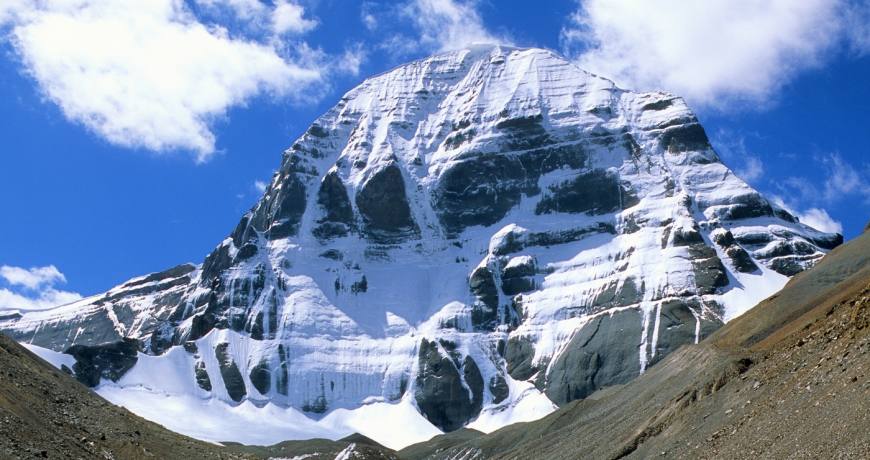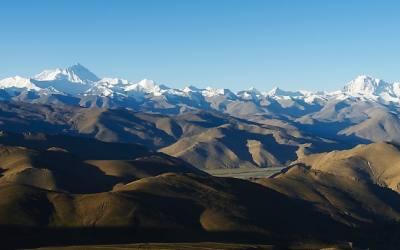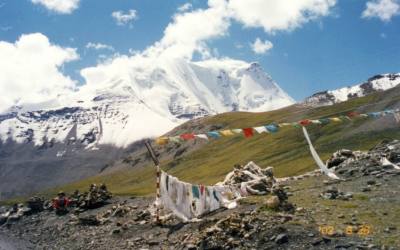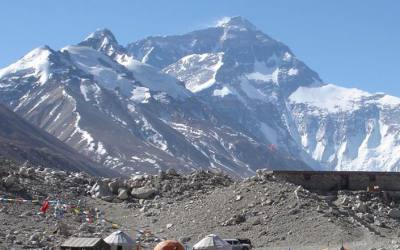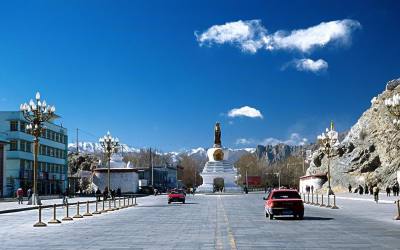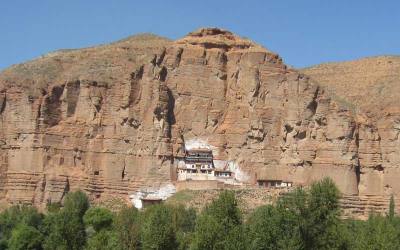Mt. Kailash, at 6714 m also known as Tise, Kailasa & Kang Rinpoche(Jewel of the Snows), has since time immemorial been celebrated in many Eastern cosmologies as Mt. Meru, the axis mundi. And as the center of the physical & metaphysical universe, Mt. Meru is sacred to the Buddhist, Jains, the Hindus & the Bonpos. For the Hindus, the mountain represents the seat of Lord Shiva; for the Buddhists, a terrestrial projection of the cosmic mandala of Dhyani-Buddhas & Boddhisatvas….The Wheel of Life; for the Bonpos, Kailash was the sacred nine storey Swastika Mountain, upon which the Bonpo founder Sherab alighted from heaven. Four of the great rivers of the Indian subcontinent originates from here: the Karnali, which feeds into the Ganges (south); the Indus (north); the Sutlez (west) & the Brahmaputra (Yarlung Tsangpo, east).
Tibet Travels & Tours offers special fixed trips to Mt. Kailash & Lake Manasorovar to facilitate pilgrims & foreign tourists. We are probably one of the few outfits that provide Nepali Sherpa staff support for all of our treks in Tibet so as to ensure similar high quality trek services that exist in Nepal. All trips are planned to arrive at Kailash on a full-moon day to obtain total & unhindered view of the holy mountain.
Day 01: Fly to Nepalgunj and transfer to your hotel.
Day 02: Fly to Simikot 2960m, and begin trek to Dharapari 2250m.
Day 03: Kermi 2682m.
Day 04: Yalbang Gompa 2950m.
Day 05: Tumkot Khola 2800m.
Day 06: Thado Dunga 3854m.
Day 07: Hilsa 3720m.
Day 08: Lake Manasarovar 4558m
Day 09: Rest day.
Day 10: Darchen
Day 11: Dri Ra Phuk gompa 5010m
Day 12: Zutul Phuk gompa 4820m –
Day 13: Tirdapuri
Day 14: Horchu 4550m.
Day 15: Paryang 4050 m.
Day 16: Saga 4600.
Day 17: Nylam
Day 18: Drive via Zhangmu to Kathmandu.
Day 01: Fly to Nepalgunj and transfer to your hotel.
Nepalgunj is in the sub-tropical lowlands of the Terai close to the border with India.
Day 02: Fly to Simikot 2960m, and begin trek to Dharapari 2250m.
The flight takes 50mins and offers some fantastic views of Himalayan peaks. The landing at the tiny mountain airstrip at Simikot is an unforgettable experience. There is an initial climb above Simikot before descending towards the village of Tuling and follow a level trail through walnut and apricot trees to the village of Dharapari.
Day 03: Kermi 2682m.
We follow the Humla Karnali and trek through rice and wheat fields to a point where the valley narrows and the river is choked with large boulders. According to legend, these represent silver fish that swam up from the Ganges and could make it no further. Above this point rice is not grown and we trek through small fields of buckwheat and open pine woodland. Towering above the surging waters of the Humla Karnali are snow capped peaks and a series of gentle waterfalls that provide ideal shower facilities!
Day 04: Yalbang Gompa 2950m.
Today we cross our first pass, the Soli La (2990m), and descend to cross the Soli Khola on a sturdy suspension bridge built in 1995. Our trail climbs above the Humla Karnali to the gompa at Yalbang that makes an excellent campsite. The views are superb and the friendly monks speak excellent English.
Day 05: Tumkot Khola 2800m.
The trail continues, at times close to the river, on a path that is built up with rocks and timber. We cross the Humla Karnali and climb gradually to Muchu (2920m) where there is a police checkpost. The trail passes below the gompa and stone houses of the village before gently descending to our camp by the river.
Day 06: Thado Dunga 3854m.
After crossing the Tumkot Khola we leave the Humla Karnali behind and will meet it again in two days time. A two hour climb brings us to a ridge crest at 3310m marked by a large cairn. We continue through open juniper woodland past Palbang to the village of Yari where there is a small shop and a school. About half an hour beyond Yari there is a nice camping place in an area of small meadows known as Dzungjen. As an aid to acclimatisation we can climb one of the ridges above Dzungjen for some excellent mountain views of the Saipal Himal.
Day 07: Hilsa 3720m.
The high pass of the Nara Lagna (4580m) is reached after a 31/2 to 4 hour climb. The summit is marked by two large cairns draped with prayer flags. Below, we can look into Tibet where the arid hillsides are a stark contrast to the greenery of the Humla region we have recently trekked through. It looks a long way down to Sher where our landcruisers await. The descent is steep and loose in places as the trail crosses scree and debris slopes. We may meet traders with large herds of sheep and goats. Each animal carries saddlebags loaded with rice from the Terai which is bound for Tibet, or if travelling in the opposite direction loads of salt bound for Nepal.
Day 08: Lake Manasarovar 4558m
We climb a short distance to Sher, a Tibetan salt trading post at 3860m that is a windswept place of government buildings where passports and daysacks will be inspected. At Sher we meet our Tibetan guide and board our landcruisers for the two hour drive to Purang, (Taklakot) at 3930m. It is a rough fantastic drive that gives a taste of what lies ahead.
We pass through Tibetan villages where prayer flags flutter from the roofs of the whitewashed houses. We will stop briefly at the village of Khojarnath where there is a large red gompa of the Sakya sect of Buddhism. This impressive building is flanked by whitewashed chortens and at it’s base is a large wall made up of mani stones and yak skulls. Inside there are many ornate paintings and statues that escaped the destruction of the Cultural Revolution. Inside the gompa are stuffed carcasses of a snow leopard and wolf.
We stop briefly at Purang where the crew can purchase any supplies needed for the remainder of our journey. We then begin a four hour drive to Chiu Gompa on the shores of Lake Manasaravar. It is an incredible drive past the snow capped peak of Gurla Mandata (7728m) as the road climbs higher onto the Tibetan Plateau. In places the road is no more than the tracks of vehicles that have passed this way before.
From the Gurla La at 4590m we get our first glimpse of Mt Kailas or Gang Rimpoche in Tibetan, (meaning ‘Precious Jewel of Snow’). The dark waters of Rakshas Tal can be whipped up by the afternoon winds and dust devils dance along the shoreline. We cross the dividing ridge between the lakes to camp at Chiu Gompa on the shores of Manasaravar, looking out at the Sacred Mountain. The sunset views from our camp are spectacular and many pilgrims come to this spot to bathe and camp before beginning their kora. Below the gompa there is a small hot spring and tea shop where it is possible to wash the dirt of the trail from our clothes and bodies.
Day 09: Rest day.
We spend a morning here to aid acclimatisation. We can explore the meditation caves along the lake shore and bathe in the sacred waters. Chiu Gompa is situated on a craggy cliff overlooking the lake and has commanding views over the plain to Mt Kailash. Inside is a small Guru Rinpoche cave that forms the most sacred part of the gompa.
Day 10: Darchen
It is a short 11/2 to 2 hour drive to Darchen, a cluster of buildings within a walled compound that marks the pilgrim’s gateway to Mt Kailas.
Day 11: Dri Ra Phuk gompa 5010m
We head north up the Lha Chu Valley and enter the ‘Valley of the Gods’ through the ‘two legged chorten’ known as Chorten Kangnyi. It is a gentle walk on a well defined path that remains on the right bank of the river. The towering cliffs each have a name and are believed to be the abode of supernatural protectors. There are many nomads herding yak and sheep to grazing areas west of the mountain. We cross the Lha Chu to camp below Dri Ra Phuk gompa at 5010m. The views of Kailas’ north face are particularly impressive from above the gompa.
Day 12: Zutul Phuk gompa 4820m
Today we cross the Dolma La 5630m. The day begins with a steep climb on a winding path over a moraine ridge to a level meadow area. Our route climbs to the Shiwa Tsal cemetary where Tibetans leave part of their clothing or a drop of blood to symbolise leaving part of their past life behind them. It is a slow steady climb to the Dolma La which is marked by streamers of prayer flags and the huge Dolma Stone that represents the goddess Dolma. The trail descends by a series of rocky switchbacks above the frozen waters of the holy lake of Gourikund to reach the valley of the Zhong Chu. We follow the river to camp in the vicinity of Zutul Phuk gompa at 4820m after 6 to 8 hrs of walking. A truly memorable day.
Day 13: Tirdapuri
Our final day on the kora is an easy three hours walking as we exit the Zhong Chu Valley on a trail that contours high above a narrow gorge. From Darchen we drive for 3 hrs to Tirdapuri, one of the holiest pilgrimage sites besides Kailash & Lake Manasorovar. There is a hot spring where one can bathe.
Day 14: Horchu 4550m.
From Tirdapuri we drive across the Tibetan plateau to camp by the northern tip of Lake Manasarovar.
Day 15: Paryang 4050 m.
The road is rough and there are some rivers to cross. Wild antelope and kiang (the Tibetan wild ass) are a common sight. This is the land of the drogpa nomads and we will pass many encampments with large herds of sheep and goats. The drives are long, bumpy and often dusty but the scenery is magnificent. Photo stops are a must!
Day 16: Saga 4600.
Drive on to Saga Camp 4600m.
Day 17: Nylam
We rejoin the main Lhasa to Kathmandu Highway where we get to see Everest as the road climbs to the Lalung La (5124m) before descending and climbing again to the Tong La at 5120m. We finally reach Nyalam and overnights at a basic hotel.
Day 18: Drive via Zhangmu to Kathmandu.
What’s Included
- Airport transfers and portage.
- Entrance fees and permits.
- All excursions and activities.
- Accommodation on sharing basis in hotels / tents.
- All meals
- Transportation via 4x wheel drive vehicles.
- Full camping support and staff.
- Yaks & Yak herders during Kailash parikrama.
- Portable Altitude Chamber(PAC) with oxygen.
What’s not Included
- Taxes
- Visa processing fees.
- Emergency rescue.
- Extra porter & transport charges in the event of landslides.
- Laundry, bar, Phone bills.
- Tips and trip insurance.
- Anything not expressly mentioned unders Services Included.
